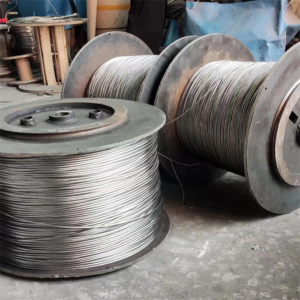Get in touch with us
Leave a message
Explore our extensive stainless steel wire range, showcasing austenitic, ferritic, and duplex alloys for a variety of industrial needs. From robust industrial grades to tailored corrosion-resistant solutions, we provide diverse material options and surface treatments to match your exact specifications. Our deep industry knowledge spans multiple wire types, delivering top performance and cost efficiency across various budgets. Whether you require standard sizes or bespoke designs, our expert team offers customized solutions supported by years of expertise.

Stainless Steel Wire is governed by standards like ASTM A580, A313, and A555, ensuring quality across grades such as 304, 316, 430, and 410. These standards define properties like tensile strength, corrosion resistance, and finish. For instance, a 304 Stainless Steel Wire aligns with ASTM A580 for general use, while 316 offers superior corrosion resistance per the same spec. Classifications split into austenitic (e.g., 304, 316), ferritic (e.g., 430), and martensitic (e.g., 410) types, with grades further distinguished by finishes like bright finish or coated options. Stainless Steel Wire, typically ranging from 0.1mm to 5mm in diameter, adheres to similar standards but is often tailored for flexible applications.
Stainless Steel Wire comes in a wide range of sizes to suit diverse needs. Common dimensions include:
This flexibility ensures Stainless Steel Wire fits everything from small fabrications to large industrial builds.
Stainless Steel Wire comes in various types and finishes, each tied to specific manufacturing processes:
| Grade | Characteristics | Applications |
|---|---|---|
| 304 Stainless Steel Wire | Excellent corrosion resistance, Good formability and weldability, Non-magnetic, Moderate strength | Food processing equipment (e.g., sieves, springs), Architectural mesh, Automotive wiring, Kitchen utensils |
| 316 Stainless Steel Wire | Superior corrosion resistance (especially in chloride environments), High durability, Non-magnetic | Marine rigging, Chemical processing screens, Surgical sutures, Coastal fencing |
| 430 Stainless Steel Wire | Magnetic, Good corrosion resistance, Lower cost than 300 series, Limited weldability | Automotive trim, Appliance wiring (e.g., ovens), Decorative mesh, Exhaust components |
| 201 Stainless Steel Wire | Good corrosion resistance, Lower cost than 304, Moderate strength, Magnetic | Automotive fasteners, Appliance interiors, Decorative cables, Industrial springs |
A:Stainless steel wire resists rust due to its chromium content, forming a protective oxide layer. However, in harsh environments like saltwater, 316 grade wire performs better than 304 to prevent corrosion.
A:304 stainless steel wire is cost-effective with good corrosion resistance for general use, while 316, with added molybdenum, offers superior resistance to pitting in chloride-rich environments like marine settings.
A:Stainless steel wire can be tough to cut due to its strength. Use high-quality wire cutters or a diamond-tipped tool for clean cuts, especially for thicker gauges, to avoid fraying or deformation.
A:Stainless steel wire can last 20-30 years in mild conditions, or 10-15 years in harsh environments like coastal areas, depending on the grade. Proper maintenance extends its lifespan significantly.
A:Yes, stainless steel wire is excellent for its corrosion resistance, strength, and versatility. It’s ideal for applications requiring durability, such as fencing, medical devices, or marine rigging.
A:Stainless steel wire is used in construction for reinforcement, in marine applications for rigging, in medical fields for sutures, and in manufacturing for springs and mesh, thanks to its durability and resistance.

Professional manufacturer of premium specialty alloys, offering stainless steel, Hastelloy, nickel-based alloys and processing services. Delivering superior metallurgical solutions for aerospace, petrochemical, marine engineering and other demanding industries.
©2025 alloy-materials.com COPYRIGHT ALL RIGHT RESERVED.